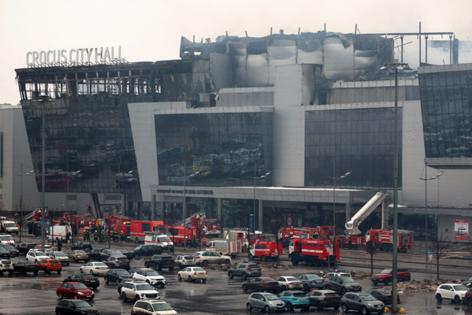Moscow terror attack: A suspect list
PARIS — As I sat in Moscow, exactly two weeks before the March 22 terror attack on the Crocus City Hall concert venue in northwest Moscow that has, reportedly, killed more than 130 people and wounded at least 150 others, a U.S. embassy warning caught my attention.
“The Embassy is monitoring reports that extremists have imminent plans to target large gatherings in Moscow, to include concerts, and U.S. citizens should be advised to avoid large gatherings over the next 48 hours,” read the statement, dated March 7. The same morning, Russia’s Federal Security Service (FSB) announced that it had liquidated a cell of an Afghan terrorist group in the Kaluga region, southwest of Moscow, whom they accused of planning to attack a Moscow synagogue. Cool. Case closed then, I guess.
Fast- forward exactly two weeks, after just returning back to Paris from Moscow, and learning that gunmen had opened fire at a rock concert in what smacked of a military-style operation. My mind went straight to the embassy warning. Was this a different planned attack set for different dates? Several media outlets were quick to attribute it to the same Afghan terror troop that Russian authorities had already busted for a supposedly separate attack, based on a murky “admission of responsibility” posted online in a Telegram channel. Does this mean that there were two planned attacks by the same group — one on a synagogue targeting Jews and another targeting anyone and everyone attending a big concert? Or is everything getting mixed up to the point of obfuscating another group of culprits who have conveniently managed to benefit from the focus being on the Afghan group with the earlier attack warning and cell roll-up?
Four suspected gunmen of the 11 detained in total (none reportedly Russian) are Tajikistan nationals. Some have already pleaded guilty and claim to have been hired online. Russian President Vladimir Putin, in a national address, mentioned that they fled in the direction of Ukraine, were caught in the Bryansk region near the border, and had in-country contacts. American officials were quick to absolve Ukraine. A bit too quick, perhaps. Ukrainian military intelligence chief, Kyrylo Budanov, has been qualified by the Washington Post as a fan of guerrilla- type “asymmetric tactics — such as the drone strikes deep into Russian territory that Budanov has often ordered,” reporting that Budanov “planned bold strikes deep behind enemy lines that unnerved officials in Washington.”
It wouldn’t be the first time that Ukraine had been linked to an attack on Russian civilians. Last year, France’s Le Monde attributed a train bombing in Russia’s Bryansk to Kyiv. Ukraine has overtly claimed attacks on Russia’s Kerch bridge linking Crimea to the Russian mainland. Political scientist and activist Darya Dugina was murdered by a car bomb near Moscow in 2022, in an attack which U.S. intelligence agencies attributed to the Ukrainian state according to the New York Times, despite claims of responsibility from a self-styled Russian resistance group that smacks of a Ukrainian secret services cutout.
The bombing that targeted Russian military blogger, Vladlen Tartarsky, leveling a Saint Petersburg café, was perpetrated by a 26-year- old woman, now serving a 27-year sentence, who walked in, handed Tartarsky a “trophy” that blew the place to smithereens. She had claimed from the outset that she was just acting on orders from a Ukrainian sending her cash and instructions that she only ever knew as “Gestalt”.
Russian writer Zakhar Prilepin manage d to survive his car being blown up in Nizhny Novgorod region last year in a hit that led Russian investigators to detain a suspect they said was acting on behalf of Ukraine.
The attack on the Nord Stream pipeline network – a centerpiece of Russian-European economic cooperation – has also been described by U.S. officials as being perpetrated by undefined “pro-Ukrainian” groups.
What remains less clear, is which nation state has the deep pockets and logistic competence to help these “pro-Ukrainian” chancers execute in the same way that German Air Force brass was recently caught on wiretap leaked by Russian intelligence planning to help Ukraine blow up the Kerch bridge.
Given Kyiv’s propensity for asymmetric warfare, its hiring of foreign fighters from all over the world for its "international legion", the deployment of useful idiots as attack instruments — the kind of folks who are competent enough to rob the bank but not quite smart enough to take off with all the money — and Washington’s admitted concern over such behaviors, why were they so quick to rule Ukraine out this time?
Instead, ISIS has been floated as the culprit. Which is stunning, really, when considering that the reason the U.S. claims to have to remain inside foreign countries touched by ISIS, like Syria, is to ensure that they can’t ever perpetrate these kinds of attacks ever again. Guess these particular ISIS perps weren’t hanging out where the oil and resources were so the U.S. could keep a keen eye on them. Or maybe the West has helped to create a whole new terrorist haven in Ukraine.
But maybe it wasn’t the main ISIS, the brand we all know, but instead a spinoff called ISIS-Khorasa (“ISIS-K”) founded in 2014 under the watchful eye of Washington’s resoundingly successful counterterrorism mission in Afghanistan. Because everyone knows that Afghans hate Russians from the Cold War days of Soviets fighting against Americans and their Afghan mujahideen allies in Afghanistan, and that ISIS “the brand” hates Russians for liquidating them in Syria. So maybe it really is as simple as this same Afghan terror group caught planning the Moscow synagogue attack two weeks earlier taking another run at it with a different group of guys. Or maybe that’s just what someone desperately wants everyone to believe.







